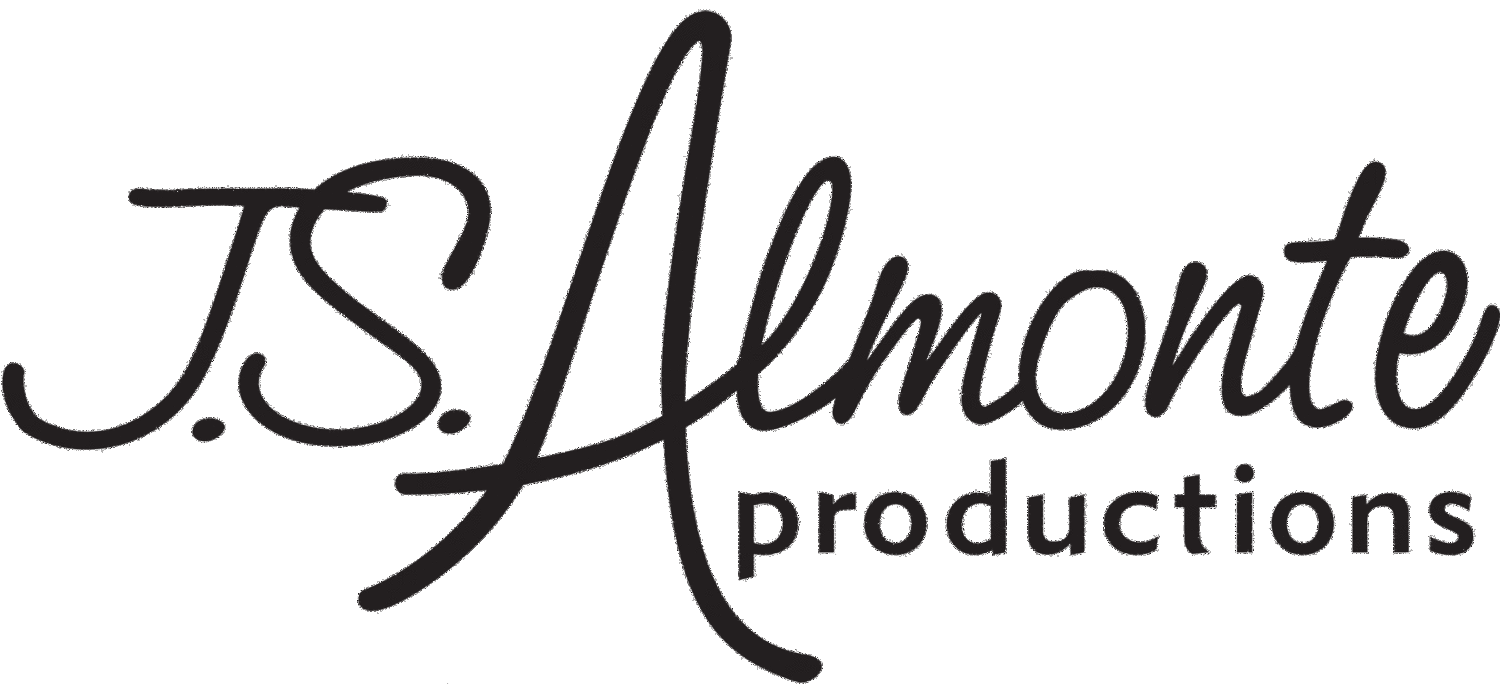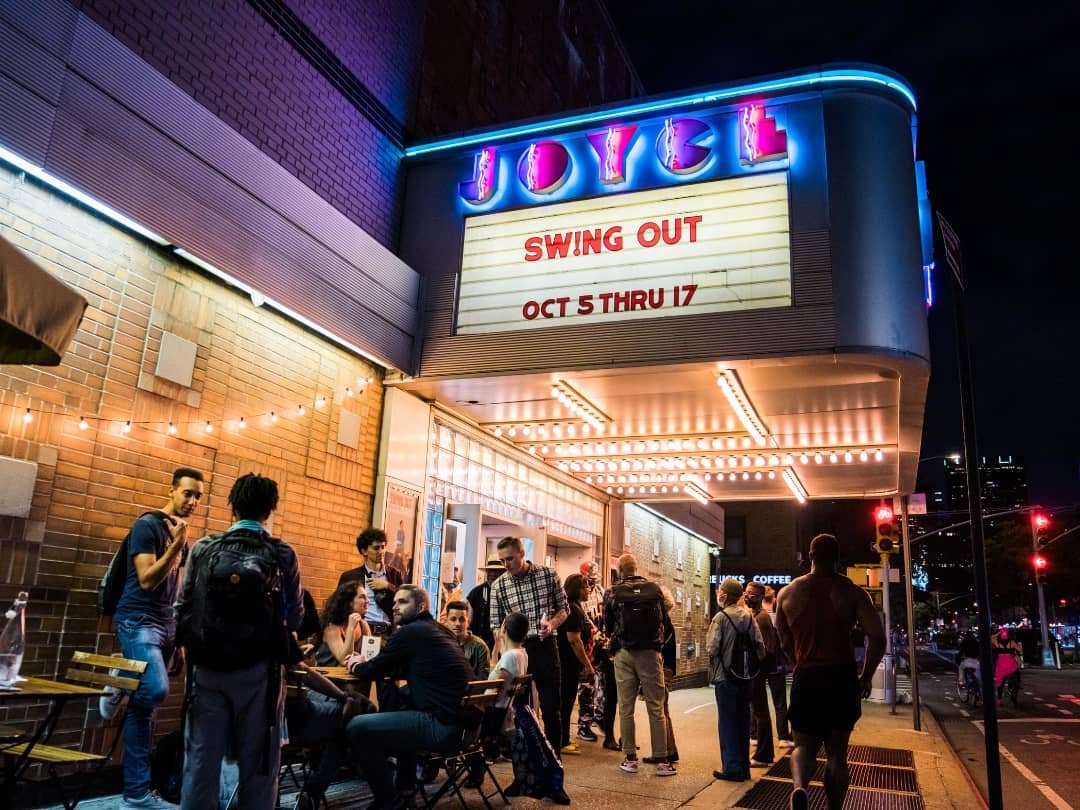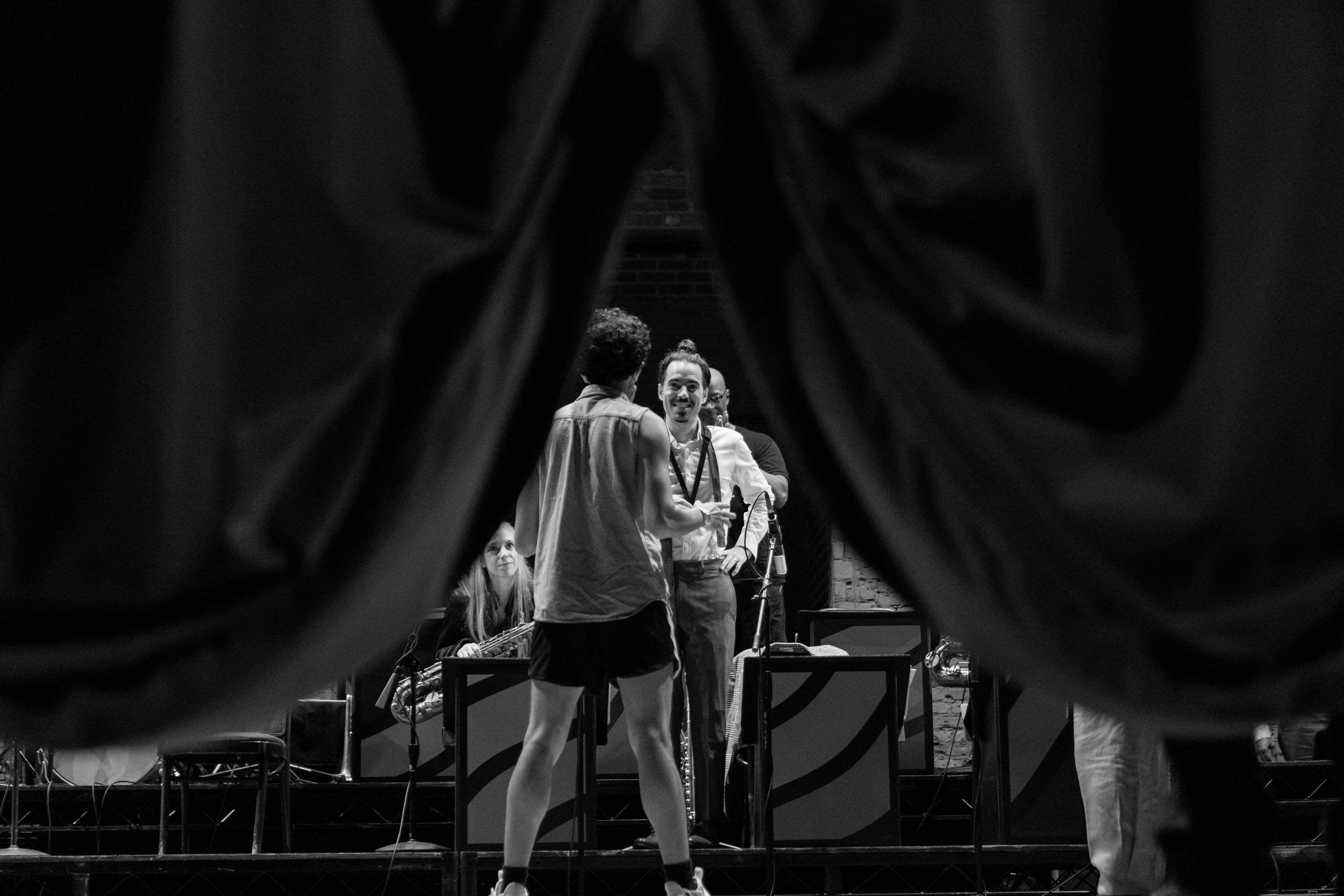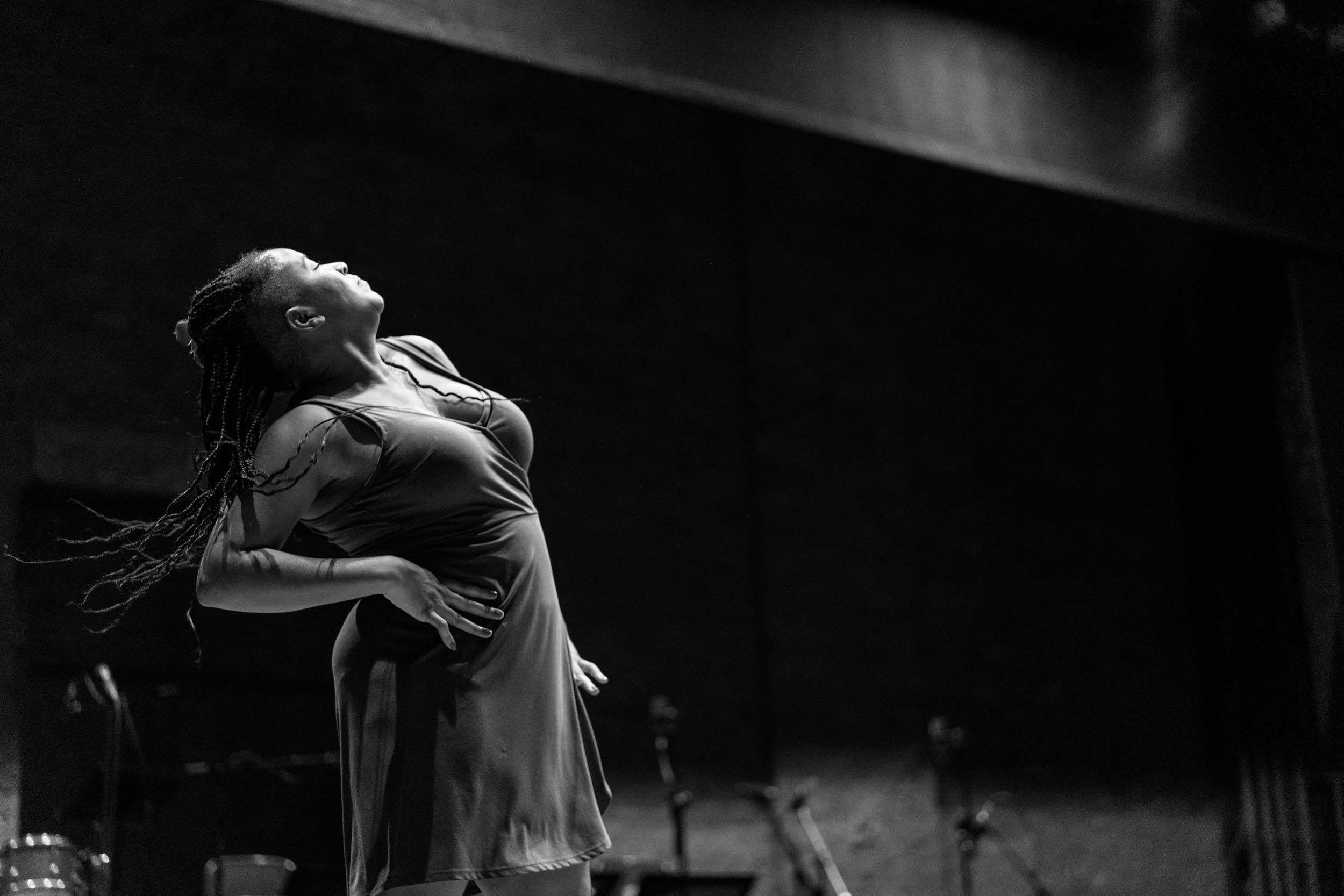A couple of years ago, I listened to LaTasha Barnes lay out the vision for what was then going to be known as Swing 2020. Despite being excited about the prospect of a show that revolved around Lindy Hop, part of me doubted that they would actually be allowed to bring that vision to the stage. When I finally saw SW!NG OUT in person last week, I was shocked that we were getting to see Lindy Hop on stage being presented like this.
I've already seen a shitty version of this show. About 20 years ago, swing was so popular that there were actually multiple stage shows touring the country using swing era music and dance as a base theme. I never saw the more high profile one, Swing! I saw another at The Warner Theater in DC that actually resembled the structure of SW!NG OUT, but had a name so generic that I'm not sure I would remember it even if you told me what it was. They probably should have used an exclamation point in their name somewhere.
There was no overall plot. Just a big band on stage playing the Swing Era hits while musical theater people did musical theater things. That sounds harsh, but even as a beginning lindy hopper who voraciously devoured anything related to the dance at the time, that show made such little impression on me that I never thought about it again until I started writing this essay.
Since then, I've had countless discussions with dancers about how they would bring Lindy Hop to stage or film again. The forbidden dream has been how to highlight the intimacy and creativity of the social aspect of the dance vs what we feared most people would expect, like dressing up in zoot suits and garter belts doing non-stop aerials to neo-swing music.
Interestingly enough there are some old timers who would insist that Lindy Hop is strictly a show dance, and what you would see on a nightly basis in the Savoy Ballroom was what they would refer to as just dancing. We don't make that distinction these days, and that is one of the central challenges that SW!NG OUT has chosen to engage with.
Back in 2012, Nathan Bugh, Evita Arce, Michael Jagger, and Giselle Anguizola performed a piece at Lindy Focus experimenting by mixing choreography and improvisation. To me, it was an interesting academic exercise, but I didn't really see any other point to it at the time. The jokes on me because they built an entire stage show on this premise. That Nathan, Evita and Michael are a part of SW!NG OUT speaks to the amount of experience that is a part of this show.
SW!NG OUT reads like a very long swinging big band arrangement. There are sections involving the whole ensemble that are tightly choreographed and executed. Then there are also pieces that are almost entirely improvised. Most of the pieces flow into each other with few breaks in the action.
The third piece of the evening, "My Baby Just Cares" features show director, Caleb Teicher, and Joshua McLean where they social dance almost the whole song. It's a pretty bold choice to defy general expectations of gender and dance roles in a slower version of Lindy Hop as the audiences' first really intimate look at the dance, separate from the raucous opening group choreographies.
I saw this show twice and the first night they were both able to nail some daring musical choices. The second night, not as much due to a couple minor miscues. I think most people didn't notice, but this number demonstrates all of the kinds of risks that they are willing to take right from the beginning.
The first night, this particular dance had a little more playful energy that could have been interpreted as very mild flirtation, but that is about how sexy the entire show got, which is to say not at all. I think a different show would have featured some more burlesque-y elements or at least had the performers dress more provocatively, but SW!NG OUT pushes "all in" on the creativity and energy of Lindy Hop. The message is that anyone can do anything with this dance, and that's where much of the exhilaration of the entire production comes from.
Speaking of wardrobe, it was interesting to note that the cast could have walked straight out the theater wearing their stage clothes, and fit comfortably in any one of the trendy bars or restaurants in the neighborhood. That highlights other theme of the show which is modernity. It is reflected in the stage design and lighting by Serena Wong and Kelly Martin as well as the clothes. Not a zoot suit or garter belt in sight.
Caleb Teicher in the fashion show at ILHC 2019 displaying the kind of fashion sensibility they eventually bring to SW!NG OUT
I got a peak backstage before one of the shows, and was explained to me that the wardrobe is almost completely based on clothes that the cast themselves already own. It helps that they are each individually pretty stylish dressers in their normal lives. From what I was told, they all brought their own clothes and then worked with the costume designer, Márion Talán de la Rosa, to select what would be best for the show. Those outfits were then duplicated, so they wouldn't have to wear the same piece of clothing for every performance.
A few years ago, I wrote about the modern appeal of Skye & Frida's Twenty Four Robbers 2007 routine and compared it to the 1998 Jump Jive & Wail Gap ad that helped to kick off the neo-swing era. In short, they both placed Lindy Hop in the modern context. However, if I had to write a part two to that essay, I'd have to dig deep into the double edged problem of taking things like that out of the context of the African American experience. SW!NG OUT doesn't go very hard overtly into that subject, but it is embedded in its roots.
The most direct nod to the past is a full performance of the Big Apple from the movie Keep Punchin'. When the modern community started to break down that routine, one of the things that jumped out at a lot of people was how no one in the original film clip was doing the movements the same way. I can't overemphasize how much that blew people's minds because that's not the way that the mostly white next generation of Lindy Hoppers understood how to dance. Years later, it perfectly encapsulates the mission statement of SW!NG OUT.
That being said, one of the criticisms that I discussed with some people was how much Eyal Vilner's arrangement of the Keep Punchin’ song is a little too "on the nose" for that routine. The way the band plays it, they now hit almost every movement and flourish in the choreography. Part of the challenge and fun of line dancing in the African American cultural context is being able to ride the groove and do your own thing within the context of the overall choreography. That being said, it is possible that this could be an unavoidable problem to have with dancers and musicians working so closely together for an extended period of time.
If I had the time and energy, I would greatly expand my post about the modern Lindy Hop community's journey through the kind of music we've wanted to dance to versus what musicians have wanted to play. The short version is that as music progressed beyond the Swing Era, movement also changed, leaving behind swing and Lindy Hop. As people came back to Lindy Hop, they realized that it wasn't enough to just mimic the vintage movements to modern sounding music. Too many people were just satisfied with doing tandem Charleston to Mambo No. 5 and calling it a day. Dedicated dancers and musicians then did the research and worked to bring back the kind of music that inspired the dance. That connected us with many of the younger musicians that were playing more traditional jazz music in New Orleans and New York during the mid 2000s. From there we built the foundation for our own big band renaissance that culminated in the Heritage Sounds projects and the week-long big band celebrations at Lindy Focus.
While the music has been incredible, the main critique of that movement is that it hasn't been very diverse. Fortunately, that is not an issue with the SW!NG OUT bandstand. Between this show and a recording session of The Scott Silbert Big Band that I had the privilege of shooting earlier this summer, and the last time I saw the tricked out version of Chelsea Reed’s band, I hope that we are moving past the idea that there aren't many black musicians that are interested in playing for Lindy Hoppers, or that they cannot do it in a style that would be fun to Lindy Hop to.
This show is nowhere near as lively if it is danced to recordings. However, I'm also not sure if a live big band playing transcriptions of original old arrangements would feel right either. The show is very much about what is happening with the dance today and that is reflected in the music. I wish I had been able to talk to Eyal Vilner some more outside of that slice of pizza he bought me after one of the shows. I'm not not sure how much he knows about our backstory of trying to figure out that perfect sound for Lindy Hop, but I do know that he listens very intently to dancers and has been actively seeking out their feedback for his most recent musical projects. That allows the show to be more of an ongoing collaboration of dance and music as it is embodied in the 4th piece that features just Eyal on saxophone in a duet with dancer Evita Arce. It's just the two of them sharing the stage with her responding to his short riffs and vice versa in a way that only two masters of their crafts are able.
There are 10 members of the band total. Not quite a big band, but enough pieces to fill the theater with that kind of sound with the help of experienced sound designer, Joseph Wolfsau. All of them are top notch jazz musicians perfectly capable of garnering their own applause at times for their solos during various songs. The standouts for me were Jon Thomas on piano and Ron Wilkins on trombone. Plus singer Imani Rousselle has an incredible voice that can be as bluesy or jazzy as the arrangements need her to be.
About midway through the first part of the show, Latasha Barnes and drummer Erán Fink collaborate in what becomes the show's true showstopper of the evening. In her SW!NG OUT biography, LaTasha notes that she isn't just a dancer, but that she is as much a “tradition bearer” who has prided herself at becoming a master of several African American dance forms from Vernacular Jazz to House to Hip-Hop and of course Lindy Hop. That training made her uniquely qualified to keep up and even challenge drummer Erán Fink who also has an impressive background that draws from jazz, R&B, and Afro-Cuban music. Unlike Evita and Eyal from earlier in the show, they do not take turns to challenge the other, but work together to create a cohesive, modern piece tying together the sounds, movements and history of the African American experience.
This show would not have been possible 20 years ago. Very few people had the skill or respect for the source material then which anchors SW!NG OUT now. That is how it was possible to have the penultimate piece be Laura Glaess and Remy Kouakuo Kouame just social dancing to the band playing “Shiny Stockings.” I don't know about you, but I think I can count on maybe my two hands the number of Lindy Hoppers that I would pay money just to watch improvise for an entire song. Fortunately, SW!NG OUT was able to get two of them.
Watching Remy and Laura social dance is like seeing an action movie sequence with a ton of unexpected twists and turns. It's an incredible reminder that this show could only exist like this because social dancing at this kind of elite level is light years ahead of anything anyone could do 20 years ago.
Coincidentally, Frankie Manning said that there were two songs he would request depending on the situation. If he wanted to impress a woman he would ask for “Shiny Stockings,” but if he wanted to bust out and leave the crowd wanting more, then he would ask for "Jumpin at The Woodside" which is the same song that follows Laura and Remy and closes the first part of the show.
One of my Lindy Hop choreography pet peeves is when couples open with a big aerial. The problem with opening so big is that everything that comes after is not as impactful, so it was nice to see SW!NG OUT hold off until the show was almost over before throwing some air. Aerials are a huge part of what made Lindy Hop a worldwide phenomenon, so it's a risky choice to not feature any until 90% through the show. However, when they do bring the fire, there isn't anything super inventive or complicated, but because of their patience, those air steps and aerials they do throw have a lot more impact because the audience is not already numb to them.
But the show isn't about acrobatics. It's about finally being able to share the joy and energy of Lindy Hop without any of the constraints of expectations or stereotypes. About 3/4 through the evening, Nathan Bugh has a solo that is not accompanied by any music. After watching Nathan perform here and there over the years, it feels like he's been preparing for this solo for his whole life. At first it feels like he's just groovin, waiting for the music to kick in, but it never does and he proceeds to dance to music that only he hears. I think it's possible that almost everyone has done some version of this dance by themselves. You know the old saying about dancing and who is looking, but if you have a story to tell, there’s nothing wrong with wanting someone to hear and see you. That's the beauty of Lindy Hop and this show. If you have something to say, there's always at least one person to listen, respond and even add to your story. And now we have an entire show dedicated to that very prospect.
A few other notes:
At some point in the evening, they randomly select the names of two performers from a hat to social dance to a different song each night. As luck would have it, AJ Howard and Evita Arce were both selected for both of the performances I saw. I think Caleb was tempted to re-do the selections on the second night, but the person yelling "Respect The Hat!" from the audience may have helped to dissuade them. I think AJ was the biggest revelation in this show to me. I've seen him around at a few events in the past few years, but he was absolutely electric in these spotlights with Evita.
I was also super happy to see Dee Daniels Locke as a part of this cast. I remember seeing her in the first ALHC I ever went to way back in 2001. Eventually, she became one of those dancers that I would periodically wonder about after not seeing her on the national circuit for many years. I later found out that she chose to concentrate on her career in education, but she started popping up at events again in the last few years. I could not be more happier to see her finish her masters thesis in time to be a part of this show.
Jennifer Nicole Jones is another face I never thought I'd see again mostly because she has a dance career outside of Lindy Hop. She showed up around a time when the Lindy Hop community was still figuring itself out creatively and stylistically. The same year that Mad Dog and ULHS changed the community conversation to be more appreciative of the dancers of the past, Jennifer and Matt Bedell showed up at ALHC and threw down an old school inspired routine that got everyone's attention. And they didn't just impress us. Their performance at the Apollo Theater a few years later brought that notoriously hard to impress crowd to their feet.
Most of what I have to say about the show is only about the first part which is a little over an hour and consists of about 18 pieces. I wish there was a better way to emphasize how much the social dancing of the second part of the show is still very much a part of the overall whole, but even the Lindy Hoppers in attendance sort of treated it as an after party. I do think that it's a pretty genius way of involving the audience even if, as someone else noticed, half of them are gaslit into thinking that most people know how to Lindy Hop when everyone is invited to the stage.
The show is also designed to include a guest performer each night. The first night I went, they welcomed world champion beatboxer, Chris Celiz, to the stage. At first glance, it sounds like an odd choice, but he did fit into the overall theme of being able to improvise a world class performance on the spot.
The 2nd night I went to was probably the most momentous for this initial run of the show outside of the opening. About two dozen of New York's Lindy Hop elders were invited to attend that evening. From that illustrious group, Mickey Davidson was called to the stage in the guest spot for a piece that I wish was a permanent part of the show. As it turns out, that will probably be her last public performance.
Mickey is one of those dancers that should be more well known in the Lindy Hop community, but she has had an extensive dance career outside of swing dance. She has still made significant contributions including being a member of Norma Miller's dance troupes in the 1980s and teaching with Frankie Manning. To be honest, I've never seen her perform outside of videos, but I did hear her tell some incredible stories about when she was invited for a talk at ILHC. That did not prepare me for the experience of bearing witness to her performance at SW!NG OUT. I had the honor of photographing her tech run before the show started, and I can attest that when she is on stage, she does not hold anything back no matter who is in the audience.
Gaby Cook made an astute observation to me during the reception for the elders after the end of the show, where she noted that some of the musicians didn't quite understand why that was more of a special night than the others. She noted that Lindy Hop isn't embraced by the academy like jazz. There are no endowed chairs for the study of the dance. We can debate whether or not that is a good thing, but the definite downside is that there's so much knowledge, wisdom and soul that never got invited to Herrang or Seoul or Melbourne or São Paulo. Even during that time of celebration and congratulations, the SW!NG OUT dancers were doing their best to be attentive to the feedback they were getting from those long time dancers. For many of those cast members who don't live in New York City especially, that may be the last opportunity they may have to be able to learn from those who came before them.
I read one review that felt that SW!NG OUT is a little too fun and ebullient. That might be true in a vacuum, but I try to survey a lot of different kinds of dances and I feel like I've seen one too many dystopian themed performances that are not very thinly veiled critiques of late stage capitalism. Any honest reckoning of the African American experience can only reveal that it has been nothing short of horrific, yet somehow that culture has created multiple artistic genres that the entire world now enjoys. SW!NG OUT does an incredible job of demonstrating how one of those forms (and snippets of a few others) is still accessible and relevant today.
Because of the way the SW!NG OUT is designed, it's never the same show from night to night. It was delightful to observe the minor differences in the two nights I attended, and get a peak into how they work out new elements from night to night. It'll be interesting to see what it could look like after 50 performances, or 100, or dare we dream, after 1000? What I can say is that it is an amazing reflection of what the dance looks and feels like now, but it also gives newcomers and veterans alike something to aspire to physically, musically, and creatively. I don't know what the future plans are for the show now that the New York City run has finished, but I can't wait to see it again.
I was able to take some behind the scenes photos on one of the days I was there, and hope to have those posted some time in the near future. Like and follow me on Instagram and Facebook to see when that happens.







